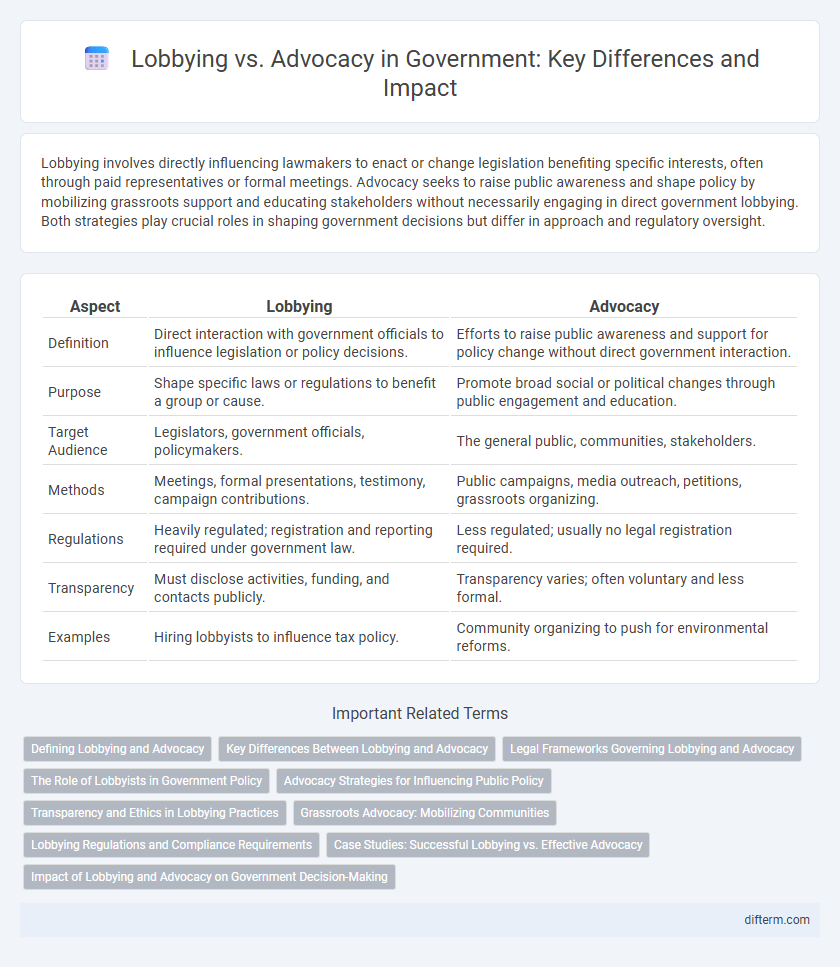Lobbying involves directly influencing lawmakers to enact or change legislation benefiting specific interests, often through paid representatives or formal meetings. Advocacy seeks to raise public awareness and shape policy by mobilizing grassroots support and educating stakeholders without necessarily engaging in direct government lobbying. Both strategies play crucial roles in shaping government decisions but differ in approach and regulatory oversight.
Table of Comparison
| Aspect | Lobbying | Advocacy |
|---|---|---|
| Definition | Direct interaction with government officials to influence legislation or policy decisions. | Efforts to raise public awareness and support for policy change without direct government interaction. |
| Purpose | Shape specific laws or regulations to benefit a group or cause. | Promote broad social or political changes through public engagement and education. |
| Target Audience | Legislators, government officials, policymakers. | The general public, communities, stakeholders. |
| Methods | Meetings, formal presentations, testimony, campaign contributions. | Public campaigns, media outreach, petitions, grassroots organizing. |
| Regulations | Heavily regulated; registration and reporting required under government law. | Less regulated; usually no legal registration required. |
| Transparency | Must disclose activities, funding, and contacts publicly. | Transparency varies; often voluntary and less formal. |
| Examples | Hiring lobbyists to influence tax policy. | Community organizing to push for environmental reforms. |
Defining Lobbying and Advocacy
Lobbying involves direct interaction with government officials to influence specific legislation or policies, often through formal channels such as meetings and testimony. Advocacy encompasses a broader range of activities aimed at shaping public opinion and policy outcomes, including grassroots mobilization, education, and public campaigns. Both lobbying and advocacy play vital roles in democratic processes, but lobbying is legally regulated with disclosure requirements, whereas advocacy is generally less restricted.
Key Differences Between Lobbying and Advocacy
Lobbying specifically involves direct interaction with government officials to influence legislation or policy decisions, often requiring registration and disclosure under legal frameworks such as the Lobbying Disclosure Act in the U.S. Advocacy encompasses broader efforts to raise public awareness and support for causes through campaigns, education, and grassroots mobilization without necessarily engaging directly with lawmakers. Key differences include the scope of activities, legal regulations, and targeted audience, with lobbying focusing on policymakers and advocacy targeting the general public or specific communities.
Legal Frameworks Governing Lobbying and Advocacy
Legal frameworks governing lobbying and advocacy establish distinct regulatory standards to ensure transparency and accountability in influencing government policy. Lobbying is typically subject to registration, disclosure requirements, and restrictions on gifts or financial contributions, whereas advocacy often benefits from broader protections under free speech statutes. These regulations vary significantly across jurisdictions, reflecting differing balances between promoting citizen participation and preventing undue influence in the political process.
The Role of Lobbyists in Government Policy
Lobbyists play a critical role in shaping government policy by providing lawmakers with specialized knowledge, data, and stakeholder perspectives that influence legislative decisions. They engage in direct communication with policymakers, draft policy proposals, and organize grassroots campaigns to align public opinion with specific interests. Unlike broader advocacy efforts that aim to raise awareness and mobilize communities, lobbying involves targeted strategies to affect policy outcomes through formal channels and established political processes.
Advocacy Strategies for Influencing Public Policy
Advocacy strategies for influencing public policy prioritize building coalitions, engaging with stakeholders, and leveraging evidence-based research to shape legislative agendas effectively. Grassroots mobilization and public awareness campaigns amplify constituent voices, enhancing policymakers' responsiveness to community needs. Strategic communication and continuous stakeholder engagement foster trust and collaboration essential for sustainable policy change.
Transparency and Ethics in Lobbying Practices
Transparency and ethics in lobbying practices are critical for maintaining public trust in government. Lobbying requires full disclosure of funding sources, meeting agendas, and intended policy outcomes to prevent undue influence and corruption. Advocacy, while promoting public interest, must also adhere to ethical standards by ensuring truthful communication and accountability to stakeholders.
Grassroots Advocacy: Mobilizing Communities
Grassroots advocacy mobilizes communities by engaging local citizens to influence government decisions through direct action and organized campaigns. This approach contrasts with lobbying, which typically involves paid professionals targeting policymakers behind the scenes. Effective grassroots efforts leverage community networks, public demonstrations, and social media platforms to create broad-based pressure for legislative or policy change.
Lobbying Regulations and Compliance Requirements
Lobbying regulations mandate detailed registration and reporting to ensure transparency in interactions between lobbyists and government officials, including disclosure of expenditures and specific issues influenced. Compliance requirements typically involve strict adherence to caps on lobbying spending, timely submission of activity reports, and avoidance of conflicts of interest to prevent unethical influence on policymaking. Enforcement mechanisms include audits, penalties, and public access to lobbying records to uphold accountability and public trust in the legislative process.
Case Studies: Successful Lobbying vs. Effective Advocacy
Case studies reveal that successful lobbying often hinges on targeted financial contributions and direct legislative engagement, as demonstrated by the tobacco industry's influence on US policy in the late 20th century. In contrast, effective advocacy relies on grassroots mobilization and sustained public awareness campaigns, exemplified by the civil rights movement's ability to enact social change through widespread community involvement and media attention. Both strategies show distinct pathways to influencing government decisions, highlighting the importance of context-specific approaches in policy impact.
Impact of Lobbying and Advocacy on Government Decision-Making
Lobbying directly influences government decision-making by providing policymakers with targeted information, expertise, and constituent perspectives, often resulting in the shaping of specific legislation or regulatory actions. Advocacy mobilizes broader public support and awareness, creating pressure on government officials through grassroots campaigns, public opinion, and media engagement. Both lobbying and advocacy play crucial roles in democracy, impacting policy outcomes by balancing specialized interest representation with collective citizen voice.
lobbying vs advocacy Infographic

 difterm.com
difterm.com